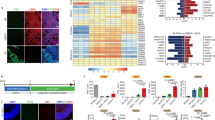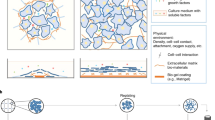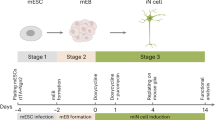Abstract
This protocol has been designed to generate neural precursor cells (NPCs) from human embryonic stem cells (hESCs) using a physiological oxygen (O2) level of 3% (previously termed hypoxia) and chemically defined conditions. The first stage involves suspension culture of hESC colonies at 3% O2, where they acquire a neuroepithelial identity over a period of 2 weeks. This timescale is comparable to that observed at 20% O2, but survival is enhanced. Sequential application of retinoic acid and purmorphamine (PM), from day 14 to day 28, directs differentiation toward spinal motor neurons. Alternatively, addition of fibroblast growth factor-8 and PM generates midbrain dopaminergic neurons. OLIG2 (encoding oligodendrocyte lineage transcription factor 2) induction in motor neuron precursors is twofold greater than that at 20% O2, whereas EN1 (encoding engrailed homeobox 1) expression is enhanced fivefold. NPCs (at 3% O2) can be differentiated into all three neural lineages, and such cultures can be maintained long term in the absence of neurotrophins. The ability to generate defined cell types at 3% O2 should represent a significant advancement for in vitro disease modeling and potentially for cell-based therapies.
This is a preview of subscription content, access via your institution
Access options
Subscribe to this journal
Receive 12 print issues and online access
$259.00 per year
only $21.58 per issue
Buy this article
- Purchase on Springer Link
- Instant access to full article PDF
Prices may be subject to local taxes which are calculated during checkout






Similar content being viewed by others
References
Zhao, T. et al. Hypoxia-driven proliferation of embryonic neural stem/progenitor cells—role of hypoxia-inducible transcription factor-1alpha. FEBS J. 275, 1824–1834 (2008).
Erceg, S., Ronaghi, M. & Stojkovic, M. Human embryonic stem cell differentiation toward regional specific neural precursors. Stem Cells 27, 78–87 (2009).
Hedlund, E. & Perlmann, T. Neuronal cell replacement in Parkinson's disease. J. Intern. Med. 266, 358–371 (2009).
Conti, L. & Cattaneo, E. Neural stem cell systems: physiological players or in vitro entities? Nat. Rev. Neurosci. 11, 176–187 (2010).
Munoz-Sanjuan, I. & Brivanlou, A.H. Neural induction, the default model and embryonic stem cells. Nat. Rev. Neurosci. 3, 271–280 (2002).
Smukler, S.R., Runciman, S.B., Xu, S. & van der Kooy, D. Embryonic stem cells assume a primitive neural stem cell fate in the absence of extrinsic influences. J. Cell Biol. 172, 79–90 (2006).
Hu, B.Y. & Zhang, S.C. Differentiation of spinal motor neurons from pluripotent human stem cells. Nat. Protoc. 4, 1295–1304 (2009).
Cimadamore, F. et al. Nicotinamide rescues human embryonic stem cell-derived neuroectoderm from parthanatic cell death. Stem Cells 27, 1772–1781 (2009).
Clarke, L. & van der Kooy, D. Low oxygen enhances primitive and definitive neural stem cell colony formation by inhibiting distinct cell death pathways. Stem Cells 27, 1879–1886 (2009).
Cho, M.S., Hwang, D.Y. & Kim, D.W. Efficient derivation of functional dopaminergic neurons from human embryonic stem cells on a large scale. Nat. Protoc. 3, 1888–1894 (2008).
Perrier, A.L. et al. Derivation of midbrain dopamine neurons from human embryonic stem cells. Proc. Natl. Acad. Sci. USA 101, 12543–12548 (2004).
Li, T.S. & Marban, E. Physiological levels of reactive oxygen species are required to maintain genomic stability in stem cells. Stem Cells 28, 1178–1185 (2010).
Kelly, C.M. et al. Neonatal desensitization allows long-term survival of neural xenotransplants without immunosuppression. Nat. Methods 6, 271–273 (2009).
Erecinska, M. & Silver, I.A. Tissue oxygen tension and brain sensitivity to hypoxia. Respir. Physiol. 128, 263–276 (2001).
Csete, M. Oxygen in the cultivation of stem cells. Ann. NY Acad. Sci. 1049, 1–8 (2005).
Simon, M.C. & Keith, B. The role of oxygen availability in embryonic development and stem cell function. Nat. Rev. Mol. Cell Biol. 9, 285–296 (2008).
Pistollato, F., Chen, H.L., Schwartz, P.H., Basso, G. & Panchision, D.M. Oxygen tension controls the expansion of human CNS precursors and the generation of astrocytes and oligodendrocytes. Mol. Cell Neurosci. 35, 424–435 (2007).
Chen, H.L. et al. Oxygen tension regulates survival and fate of mouse central nervous system precursors at multiple levels. Stem Cells 25, 2291–2301 (2007).
Covello, K.L. et al. HIF-2alpha regulates Oct-4: effects of hypoxia on stem cell function, embryonic development, and tumor growth. Genes Dev. 20, 557–570 (2006).
Gustafsson, M.V. et al. Hypoxia requires notch signaling to maintain the undifferentiated cell state. Dev. Cell 9, 617–628 (2005).
Forristal, C.E., Wright, K.L., Hanley, N.A., Oreffo, R.O. & Houghton, F.D. Hypoxia inducible factors regulate pluripotency and proliferation in human embryonic stem cells cultured at reduced oxygen tensions. Reproduction 139, 85–97 (2010).
Yoshida, Y., Takahashi, K., Okita, K., Ichisaka, T. & Yamanaka, S. Hypoxia enhances the generation of induced pluripotent stem cells. Cell Stem Cell 5, 237–241 (2009).
Mohyeldin, A., Garzon-Muvdi, T. & Quinones-Hinojosa, A. Oxygen in stem cell biology: a critical component of the stem cell niche. Cell Stem Cell 7, 150–161 (2010).
Morrison, S.J. et al. Culture in reduced levels of oxygen promotes clonogenic sympathoadrenal differentiation by isolated neural crest stem cells. J. Neurosci. 20, 7370–7376 (2000).
Studer, L. et al. Enhanced proliferation, survival, and dopaminergic differentiation of CNS precursors in lowered oxygen. J. Neurosci. 20, 7377–7383 (2000).
Milosevic, J. et al. Low atmospheric oxygen avoids maturation, senescence and cell death of murine mesencephalic neural precursors. J. Neurochem. 92, 718–729 (2005).
Storch, A. et al. Long-term proliferation and dopaminergic differentiation of human mesencephalic neural precursor cells. Exp. Neurol. 170, 317–325 (2001).
Maciaczyk, J., Singec, I., Maciaczyk, D. & Nikkhah, G. Combined use of BDNF, ascorbic acid, low oxygen, and prolonged differentiation time generates tyrosine hydroxylase-expressing neurons after long-term in vitro expansion of human fetal midbrain precursor cells. Exp. Neurol. 213, 354–362 (2008).
Akundi, R.S. & Rivkees, S.A. Hypoxia alters cell cycle regulatory protein expression and induces premature maturation of oligodendrocyte precursor cells. PLoS One 4, e4739 (2009).
Li, D., Marks, J.D., Schumacker, P.T., Young, R.M. & Brorson, J.R. Physiological hypoxia promotes survival of cultured cortical neurons. Eur. J. Neurosci. 22, 1319–1326 (2005).
Stacpoole, S.R. et al. Derivation of neural precursor cells from human ES cells at 3% O(2) is efficient, enhances survival and presents no barrier to regional specification and functional differentiation. Cell Death Differ. 18, 1016–1023 (2011).
Siddiq, A. et al. Selective inhibition of hypoxia-inducible factor (HIF) prolyl-hydroxylase 1 mediates neuroprotection against normoxic oxidative death via HIF- and CREB-independent pathways. J. Neurosci. 29, 8828–8838 (2009).
Yan, Y. et al. Directed differentiation of dopaminergic neuronal subtypes from human embryonic stem cells. Stem Cells 23, 781–790 (2005).
Li, X.J. et al. Directed differentiation of ventral spinal progenitors and motor neurons from human embryonic stem cells by small molecules. Stem Cells 26, 886–893 (2008).
Joannides, A.J. et al. A scaleable and defined system for generating neural stem cells from human embryonic stem cells. Stem Cells 25, 731–737 (2007).
Vallier, L. Serum-free and feeder-free culture conditions for human embryonic stem cells. Methods Mol. Biol. 690, 57–66 (2011).
Cho, M.S. et al. Highly efficient and large-scale generation of functional dopamine neurons from human embryonic stem cells. Proc. Natl. Acad. Sci. USA 105, 3392–3397 (2008).
Svendsen, C.N. et al. A new method for the rapid and long term growth of human neural precursor cells. J. Neurosci. Methods 85, 141–152 (1998).
Trotti, D., Danbolt, N.C. & Volterra, A. Glutamate transporters are oxidant-vulnerable: a molecular link between oxidative and excitotoxic neurodegeneration? Trends Pharmacol. Sci. 19, 328–334 (1998).
Behl, C. & Moosmann, B. Oxidative nerve cell death in Alzheimer's disease and stroke: antioxidants as neuroprotective compounds. Biol. Chem. 383, 521–536 (2002).
Wright, W.E. & Shay, J.W. Inexpensive low-oxygen incubators. Nat. Protoc. 1, 2088–2090 (2006).
Allen, C.B., Schneider, B.K. & White, C.W. Limitations to oxygen diffusion and equilibration in in vitro cell exposure systems in hyperoxia and hypoxia. Am. J. Physiol. Lung Cell Mol. Physiol. 281, L1021–L1027 (2001).
Wion, D., Christen, T., Barbier, E.L. & Coles, J.A. PO2 matters in stem cell culture. Cell Stem Cell 5, 242–243 (2009).
Hartung, O., Huo, H., Daley, G.Q. & Schlaeger, T.M. Clump passaging and expansion of human embryonic and induced pluripotent stem cells on mouse embryonic fibroblast feeder cells. Curr. Protoc. Stem Cell Biol. 14, 1C.10.1–1C.10.15 (2010).
Patani, R. et al. Activin/Nodal inhibition alone accelerates highly efficient neural conversion from human embryonic stem cells and imposes a caudal positional identity. PLoS One 4, e7327 (2009).
Moe, M.C. et al. Multipotent progenitor cells from the adult human brain: neurophysiological differentiation to mature neurons. Brain 128, 2189–2199 (2005).
Bouhon, I.A., Joannides, A., Kato, H., Chandran, S. & Allen, N.D. Embryonic stem cell-derived neural progenitors display temporal restriction to neural patterning. Stem Cells 24, 1908–1913 (2006).
Cummins, T.R., Rush, A.M., Estacion, M., Dib-Hajj, S.D. & Waxman, S.G. Voltage-clamp and current-clamp recordings from mammalian DRG neurons. Nat. Protoc. 4, 1103–1112 (2009).
Molleman, A. Patch Clamping: An Introductory Guide to Patch Clamp Electrophysiology (John Wiley, 2003).
Acknowledgements
We are grateful to L. Vallier for kindly providing feeder-free ES cells, M. Alexander for valuable technical assistance and R. Barker for the use of the low-oxygen incubator. This work was supported by the Multiple Sclerosis Society UK, the Evelyn Trust, the Medical Research Council, the National Institute for Health Research (Cambridge Biomedical Research Centre), the Wellcome Trust (A.L.) and the Royal Society (R.K.). S.R.L.S. is supported by a Sir David Walker Fellowship, a joint Medical Research Council and Multiple Sclerosis Society Clinical Research Training Fellowship (no. G0800487) and a Raymond and Beverly Sackler Studentship. We obtained the hybridomas Hb9 (MNR2) and En1, developed by T.M. Jessell and S. Brenner-Morton, from the Developmental Studies Hybridoma bank developed under the auspices of the National Institute of Child Health and Human Development and maintained by the Department of Biology at the University of Iowa.
Author information
Authors and Affiliations
Contributions
S.R.L.S., B.B., D.J.W. and S.C. designed the experiments; S.R.L.S., B.B. and X.L.H. conducted the experiments; A.L. and R.K. performed the neuronal electrophysiology; S.R.L.S., B.B., A.L. and R.K. analyzed the data; A.C., R.J.M.F. and S.C. supervised the project; S.R.L.S., B.B., D.J.W., A.L., A.C., R.K., R.J.M.F. and S.C. wrote the protocol.
Corresponding author
Ethics declarations
Competing interests
The authors declare no competing financial interests.
Rights and permissions
About this article
Cite this article
Stacpoole, S., Bilican, B., Webber, D. et al. Efficient derivation of NPCs, spinal motor neurons and midbrain dopaminergic neurons from hESCs at 3% oxygen. Nat Protoc 6, 1229–1240 (2011). https://doi.org/10.1038/nprot.2011.380
Published:
Issue Date:
DOI: https://doi.org/10.1038/nprot.2011.380
This article is cited by
-
3D human induced pluripotent stem cell–derived bioengineered skeletal muscles for tissue, disease and therapy modeling
Nature Protocols (2023)
-
Nup133 and ERα mediate the differential effects of hyperoxia-induced damage in male and female OPCs
Molecular and Cellular Pediatrics (2020)
-
Neural cells generated from human induced pluripotent stem cells as a model of CNS involvement in mucopolysaccharidosis type II
Journal of Inherited Metabolic Disease (2018)
-
Pluripotent Human embryonic stem cell derived neural lineages for in vitro modelling of enterovirus 71 infection and therapy
Virology Journal (2016)
-
Cell cycle and p53 gate the direct conversion of human fibroblasts to dopaminergic neurons
Nature Communications (2015)
Comments
By submitting a comment you agree to abide by our Terms and Community Guidelines. If you find something abusive or that does not comply with our terms or guidelines please flag it as inappropriate.



